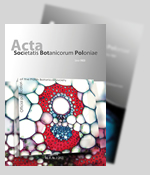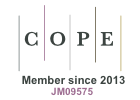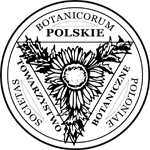Malus ×oxysepala (M. domestica Borkh. × M. sylvestris Mill.) – a new spontaneous apple hybrid
Abstract
A study of the three Malus species (M. domestica, M. sylvestris, and a hybrid species, M. domestica × M. sylvestris, which was named M. ×oxysepala) was carried out based on the morphological and micromorphological features and molecular investigation. Observations performed for 47 quantitative traits showed that this hybrid species exhibits intermediate values between M. domestica and M. sylvestris, or are similar to traits of one of the parents. Sepals proved to be the best diagnostic feature because they were acuminate and much longer than sepals in M. domestica and M. sylvestris. Seed testa cells are distinct, rimmed with straight anticlinal walls and strongly bulged periclinal walls. Simultaneous genetic analyses based on PCR RAPD reactions fully confirmed earlier morphological observations. Genetic profiles of the hybrid obtained with the use of 30 primers, next to species-specific amplification products, contain common products with each of the parents. However, both the profile analysis and the dendrogram constructed on its basis showed that the hybrid is genetically closer to M. sylvestris.
Keywords
Full Text:
PDFReferences
Bugała W. Drzewa i krzewy dla terenów zieleni. Warsaw: PWRiL; 1991.
Robinson JP, Harris SA, Juniper BE. Taxonomy of the genus Malus Mill. (Rosaceae) with emphasis on the cultivated apple, Malus domestica Borkh. Plant Syst Evol. 2001;226(1–2):35–58. http://dx.doi.org/10.1007/s006060170072
Mirek Z, Piękoś-Mirkowa H, Zając A, Zając M. Flowering plants and pteridophytes of Poland a checklist. Cracow: W. Szafer Institute of Botany, Polish Academy of Sciences; 2002. (Biodiversity of Poland; vol 1).
Larsen AS, Jensen M, Kjær ED. Crossability between wild (Malus sylvestris) and cultivated (M. domestica) apples. Silvae Genet. 2008;57(3):127–132.
Kościelny S, Sękowski B. Drzewa i krzewy klucze do oznaczania. Warsaw: PWRiL; 1971.
Białobok S. Dzikie drzewa owocowe. Poznań: Polish Academy of Sciences; 1990.
Pawłowski B. Podrodzina: Rosoideae, Różowate. In: Szafer W, Pawłowski B, editors. Flora Polska. Rośliny naczyniowe Polski i ziem ościennych. Cracow: Polish Scientific Publishers PWN; 1998. p. 91–294. (vol 7).
Gleason HA. Illustrated flora of the northeastern United States and adjacent Canada. V. 2. Saururaceae to Cornaceae, Lizard’s-tail to Cotton Gum. New York NY: The New York Botanical Garden; 1958.
Terpó A. Malus Miller. In: Tutin TG, Heywood VH, Burges NA, Moore DM, Valentine DH, Walters SM, et al., editors. Flora Europaea. V. 2. Rosaceae to Umbelliferae. Cambridge: Cambridge University Press; 1968.
Garcke A. Illustrierte Flora: Deutschland und angrenzende Gebiete. Berlin, Hamburg: P. Parey; 1972.
Krüssmann G. Handbuch der Laubgehölze. Berlin, Hamburg: P. Parey; 1977.
Dostál J. Nová Kvĕtena ČSSR. Prague: Academia; 1989.
Hegi G. Illustrierte Flora von Mitteleuropa. IV, 2B: Spermatophyta: Angiospermae, Dicotyledones 2(3). Berlin: Blackwell Wissenschafts; 1995.
Cuizhi G, Sponberg SA. Malus Miller, Gard. In: Wu Z, Raven PH, editors. Flora of China: Pittosporaceae through Connaraceae. Beijing: Science Press; 2003. p. 179–189. (vol 9).
Seneta W, Dolatowski J. Dendrologia. Warsaw: Polish Scientific Publishers PWN; 2006.
Haeupler H, Muer T. Bildatlas der Farn- und Blütenpflanzen Deutschlands. 2nd ed. Stuttgart: Ulmer Eugen Verlag; 2007.
Dunemann F, Kahnau R, Schmidt H. Genetic relationships in Malus evaluated by RAPD “fingerprinting” of cultivars and wild species. Plant Breed. 1994;113(2):150–159. http://dx.doi.org/10.1111/j.1439-0523.1994.tb00717.x
Markussen T, Kruger J, Schmidt H, Dunemann F. Identification of PCR-based markers linked to the powdery-mildew-resistance gene Pl1 from Malus robusta in cultivated apple. Plant Breed. 1995;114(6):530–534. http://dx.doi.org/10.1111/j.1439-0523.1995.tb00850.x
Yang H, Kruger J. Identification of an RAPD marker linked to the Vf gene for scab resistance in apples. Plant Breed. 1994;112(4):323–329. http://dx.doi.org/10.1111/j.1439-0523.1994.tb00691.x
Doyle J. DNA protocols for plants-CTAB total DNA isolation. In: Hewitt GM, Johnston A, Young JPW, Aguirre J, editors. Molecular techniques in taxonomy. Berlin: Springer-Verlag; 1991. p. 283–293.
Nei M, Li WH. Mathematical model for studying genetic variation in terms of restriction endonucleases. Proc Natl Acad Sci USA. 1979;76(10):5269–5273. http://dx.doi.org/10.1073/pnas.76.10.5269
Niklas KJ. The evolutionary biology of plants. Chicago Il: University of Chicago Press; 1997.
Coart E, Van Glabeke S, De Loose M, Larsen AS, RoldáN-Ruiz I. Chloroplast diversity in the genus Malus: new insights into the relationship between the European wild apple [Malus sylvestris (L.) Mill.] and the domesticated apple (Malus domestica Borkh.). Mol Ecol. 2006;15(8):2171–2182. http://dx.doi.org/10.1111/j.1365-294X.2006.02924.x
Velasco R, Zharkikh A, Affourtit J, Dhingra A, Cestaro A, Kalyanaraman A, et al. The genome of the domesticated apple (Malus ×domestica Borkh.). Nat Genet. 2010;42(10):833–839. http://dx.doi.org/10.1038/ng.654
Forte AV, Ignatov AN, Ponomarenko VV, Dorokhov DB, Savelyev NI. Phylogeny of the Malus (apple tree) species, inferred from the morphological traits and molecular DNA analysis. Russ J Genet. 2002;38(10):1150–1161. http://dx.doi.org/10.1023/A:1020648720175
DOI: https://doi.org/10.5586/asbp.2013.016
|
|
|







